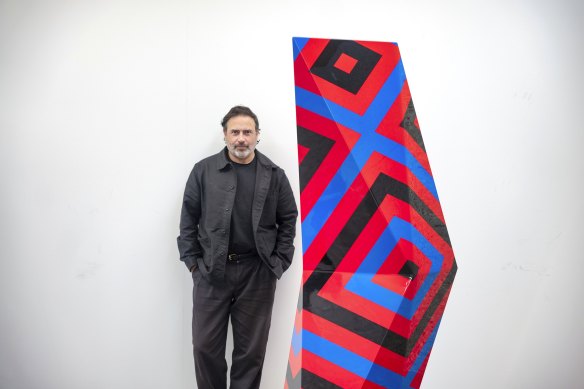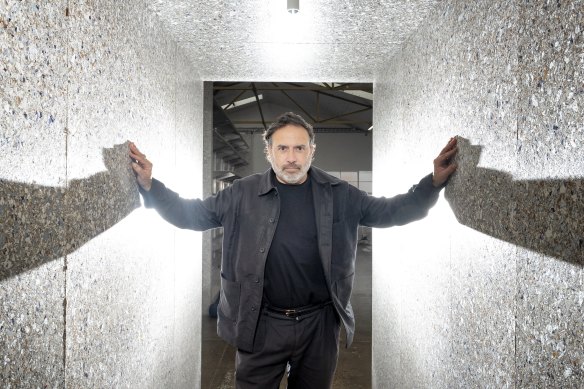- Exclusive
- Culture
- Art & design
- Arts
How this artist went from teenage graffiti to a retrospective at the NGV
A gold Rolls-Royce. Pink neon sculptures of a spear-throwing warrior. A crown depicted in spray paint. Rapper Briggs as a sensei, leading a protest chant.
These disparate images have all sprung from the mind of Kamilaroi artist Reko Rennie, whose distinctive, powerful work will be showcased by the National Gallery of Victoria in REKOSPECTIVE: The Art of Reko Rennie.

The work of artist Reko Rennie will be the focus of a retrospective at the NGV later this year. Credit: Luis Enrique Ascui
“It’s a real celebration of the work that I’ve made to date and the power of art and having a voice,” Rennie says.
The Footscray-born artist started out with graffiti, but over the course of his career has moved to film, sculpture and painting. Rennie’s grandmother was part of the Stolen Generations, taken from her parents aged eight. Tough issues lie at the core of his work, which makes statements about identity, colonisation and the latter’s devastating impact on Indigenous people.

Reko Rennie’s OA WARRIOR I (pink), 2020. Credit: Reko Rennie
The NGV show at Fed Square’s Ian Potter Centre in October will feature 100 works, including new figurative works. It’s going to be a bit heavy, Rennie says. “As we’ve seen, there are changing attitudes in society: it’s far more acceptable to be a racist these days in contemporary Australia.”
He points to the recent referendum on the Voice to parliament and the bigoted tone of so many of the No arguments.
Appropriating symbols of royalty and using street art motifs and language – instead of OG for Original Gangster, he uses OA for Original Aboriginal, for example – Rennie’s work manages to be at once playful and powerful.
“I’ve never forgotten where I come from. You work and strive for a lot more when you come from very little,” he says. “That was instilled in me from my mother and my grandmother.”
The 50-year-old was a journalist at The Age before pursuing art full-time but realised “it was through art that I could have an unfiltered voice”.
His is a contemporary urban Aboriginal perspective. “It’s about breaking down these stereotypes, romanticised notions of Aboriginality ... To lump us as one monocultured identity is just like saying all of Europe is the same.

‘It was through art that I could have an unfiltered voice’, says Reko Rennie.Credit: Luis Enrique Ascui
“The urban voice is really important because the reality is a lot of mob were moved and dislocated from their lands.”
The artist’s video OA_RR, telling his grandmother’s story, showed at Venice in 2017, and Remember Us, 2023 – a marble plinth chiselled with Roman numerals documenting 551 Aboriginal deaths in custody recorded by the Australian Institute of Criminology – sits atop Sydney’s Museum of Contemporary Art.
Rennie has fond memories of the NGV growing up. The family didn’t have a lot of money, so when visiting the city they went to places that were free: the parks, the museum and the gallery.
The gallery’s water wall was a joy but he was equally fascinated by what was inside: “Being exposed to that culture obviously made a mark ... looking at art gave me remarkable insights.”
Rekospective: The Art of Reko Rennie runs October 11 until January 27, 2025, at The Ian Potter Centre: NGV Australia.